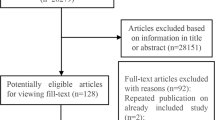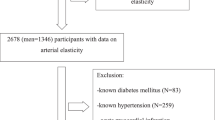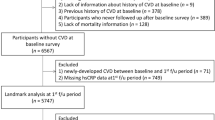Abstract
We examined the association between C-reactive protein (CRP) and left ventricular mass index (LVMI), and investigated prospectively the incidence of cardiovascular disease (CVD) in asymptomatic subjects with essential hypertension. A total of 629 subjects (mean age 62 years, 51% female) free of prior CVD were included in this study. In cross-sectional analysis at baseline, patients were divided into three groups according to serum CRP levels: <1, 1 to 2, and >2 mg/L. In multivariate analysis, LVMI increased in a stepwise fashion with increasing CRP levels in both men (127.2±2.9, 138.7±4.1, 141.8±3.5 g/m2, respectively; F=6.85, p=0.001) and women (119.5±3.6, 129.2±4.9, 130.2±4.8 g/m2; F=4.23, p=0.031). During follow-up (mean 32 months), 52 subjects (19 female) developed CVD. Kaplan-Meier analysis with log-rank tests showed a significantly poorer event-free survival rate in the group with elevated CRP levels (≥1 mg/L) (χ2=8.22, p<0.01) and that with left ventricular hypertrophy (LVH) (χ2=19.91, p<0.01). When participants were divided into four groups on the basis of CRP level (<1 or ≥1 mg/L) and the absence or presence of LVH, the group with LVH/CRP≥1 mg/L showed markedly poorer event-free survival (χ2=28.02, p<0.01), and the adjusted hazard ratio by multivariate Cox regression analysis was 2.65 (95% confidence interval [CI]=1.55–5.46, p<0.01). In the subgroup with LVH (n=362), a significantly lower event-free survival rate of CVD was also observed in the group with CRP≥1 mg/L (hazard ratio [HR] 1.37, 95% CI: 1.02–1.85, p=0.025). Our findings demonstrate that the CRP level is independently associated with LVMI, and suggest that measurement of CRP may provide clinically important prognostic information to supplement LVH.
Similar content being viewed by others
Article PDF
References
Ross R : Atherosclerosis—an inflammatory disease. N Engl J Med 1999; 340: 115–126.
Verma S, Wang CH, Li SH, et al: A self-fulfilling prophecy: C-reactive protein attenuates nitric oxide production and inhibits angiogenesis. Circulation 2002; 106: 913–919.
Sesso HD, Buring JE, Rifai N, Blake GJ, Gaziano JM, Ridker PM : C-reactive protein and the risk of developing hypertension. JAMA 2003; 290: 2945–2951.
Venugopal SK, Devaraj S, Yuhanna I, Shaul P, Jialal I : Demonstration that C-reactive protein decreases eNOS expression and bioactivity in human aortic endothelial cells. Circulation 2002; 106: 1439–1441.
Ridker PM, Cushman M, Stampfer MJ, Tracy RP, Hennekens CH : Inflammation, aspirin, and the risk of cardiovascular disease in apparently healthy men. N Engl J Med 1997; 336: 973–979.
Koenig W, Sund M, Frohlich M, et al: C-Reactive protein, a sensitive marker of inflammation, predicts future risk of coronary heart disease in initially healthy middle-aged men: results from the MONICA (Monitoring Trends and Determinants in Cardiovascular Disease) Augsburg Cohort Study, 1984 to 1992. Circulation 1999; 99: 237–242.
Danesh J, Whincup P, Walker M, et al: Low grade inflammation and coronary heart disease: prospective study and updated meta-analyses. BMJ 2000; 321: 199–204.
Ridker PM, Stampfer MJ, Rifai N : Novel risk factors for systemic atherosclerosis: a comparison of C-reactive protein, fibrinogen, homocysteine, lipoprotein(a), and standard cholesterol screening as predictors of peripheral arterial disease. JAMA 2001; 285: 2481–2485.
Rost NS, Wolf PA, Kase CS, et al: Plasma concentration of C-reactive protein and risk of ischemic stroke and transient ischemic attack: the Framingham study. Stroke 2001; 32: 2575–2579.
Tracy RP, Lemaitre RN, Psaty BM, et al: Relationship of C-reactive protein to risk of cardiovascular disease in the elderly. Results from the Cardiovascular Health Study and the Rural Health Promotion Project. Arterioscler Thromb Vasc Biol 1997; 17: 1121–1127.
2003 European Society of Hypertension–European Society of Cardiology guidelines for the management of arterial hypertension. J Hypertens 2003; 21: 1011–1053.
Pearson TA, Mensah GA, Alexander RW, et al: Markers of inflammation and cardiovascular disease: application to clinical and public health practice: a statement for healthcare professionals from the Centers for Disease Control and Prevention and the American Heart Association. Circulation 2003; 107: 499–511.
Festa A, D'Agostino R Jr, Howard G, Mykkanen L, Tracy RP, Haffner SM : Chronic subclinical inflammation as part of the insulin resistance syndrome: the Insulin Resistance Atherosclerosis Study (IRAS). Circulation 2000; 102: 42–47.
Yudkin JS, Stehouwer CD, Emeis JJ, Coppack SW : C-reactive protein in healthy subjects: associations with obesity, insulin resistance, and endothelial dysfunction: a potential role for cytokines originating from adipose tissue? Arterioscler Thromb Vasc Biol 1999; 19: 972–978.
Kim BS, Jeon DS, Shin MJ, et al: Persistent elevation of C-reactive protein may predict cardiac hypertrophy and dysfunction in patients maintained on hemodialysis. Am J Nephrol 2005; 25: 189–195.
Olsen MH, Christensen MK, Hansen TW, et al: High-sensitivity C-reactive protein is only weakly related to cardiovascular damage after adjustment for traditional cardiovascular risk factors. J Hypertens 2006; 24: 655–661.
Conen D, Zeller A, Pfisterer M, Martina B : Usefulness of B-type natriuretic peptide and C-reactive protein in predicting the presence or absence of left ventricular hypertrophy in patients with systemic hypertension. Am J Cardiol 2006; 97: 249–252.
Palmieri V, Tracy RP, Roman MJ, et al: Relation of left ventricular hypertrophy to inflammation and albuminuria in adults with type 2 diabetes: the strong heart study. Diabetes Care 2003; 26: 2764–2769.
Yasunari K, Maeda K, Watanabe T, Nakamura M, Yoshikawa J, Asada A : Comparative effects of valsartan versus amlodipine on left ventricular mass and reactive oxygen species formation by monocytes in hypertensive patients with left ventricular hypertrophy. J Am Coll Cardiol 2004; 43: 2116–2123.
The Expert Committee on the Diagnosis and Classification of Diabetes Mellitus : Report of the Expert Committee on the Diagnosis and Classification of Diabetes Mellitus. Diabetes Care 2003; 26 ( Suppl 1): S5–S20.
Iwashima Y, Horio T, Kamide K, Rakugi H, Ogihara T, Kawano Y : Uric acid, left ventricular mass index, and risk of cardiovascular disease in essential hypertension. Hypertension 2006; 47: 195–202.
Iwashima Y, Horio T, Takami Y, et al: Effects of the creation of arteriovenous fistula for hemodialysis on cardiac function and natriuretic peptide levels in CRF. Am J Kidney Dis 2002; 40: 974–982.
Schiller NB, Shah PM, Crawford M, et al: Recommendations for quantitation of the left ventricle by two-dimensional echocardiography. American Society of Echocardiography Committee on Standards, Subcommittee on Quantitation of Two-Dimensional Echocardiograms. J Am Soc Echocardiogr 1989; 2: 358–367.
Cooper JW, Nanda NC, Philpot EF, Fan P : Evaluation of valvular regurgitation by color Doppler. J Am Soc Echocardiogr 1989; 2: 56–66.
Devereux RB, Alonso DR, Lutas EM, et al: Echocardiographic assessment of left ventricular hypertrophy: comparison to necropsy findings. Am J Cardiol 1986; 57: 450–458.
Basnight MA, Gonzalez MS, Kershenovich SC, Appleton CP : Pulmonary venous flow velocity: relation to hemodynamics, mitral flow velocity and left atrial volume, and ejection fraction. J Am Soc Echocardiogr 1991; 4: 547–558.
McKee PA, Castelli WP, McNamara PM, Kannel WB : The natural history of congestive heart failure: the Framingham study. N Engl J Med 1971; 285: 1441–1446.
Mosterd A, Deckers JW, Hoes AW, et al: Classification of heart failure in population based research: an assessment of six heart failure scores. Eur J Epidemiol 1997; 13: 491–502.
Hammond IW, Devereux RB, Alderman MH, et al: The prevalence and correlates of echocardiographic left ventricular hypertrophy among employed patients with uncomplicated hypertension. J Am Coll Cardiol 1986; 7: 639–650.
Saijo Y, Yoshioka E, Fukui T, Kawaharada M, Kishi R : Metabolic syndrome, C-reactive protein and increased arterial stiffness in Japanese subjects. Hypertens Res 2006; 29: 589–596.
Frohlich M, Imhof A, Berg G, et al: Association between C-reactive protein and features of the metabolic syndrome: a population-based study. Diabetes Care 2000; 23: 1835–1839.
Ford ES : Body mass index, diabetes, and C-reactive protein among U.S. adults. Diabetes Care 1999; 22: 1971–1977.
Blake GJ, Rifai N, Buring JE, Ridker PM : Blood pressure, C-reactive protein, and risk of future cardiovascular events. Circulation 2003; 108: 2993–2999.
Jialal I, Devaraj S, Venugopal SK : C-reactive protein: risk marker or mediator in atherothrombosis? Hypertension 2004; 44: 6–11.
Zhong W, Zen Q, Tebo J, Schlottmann K, Coggeshall M, Mortensen RF : Effect of human C-reactive protein on chemokine and chemotactic factor–induced neutrophil chemotaxis and signaling. J Immunol 1998; 161: 2533–2540.
Mazer SP, Rabbani LE : Evidence for C-reactive protein's role in (CRP) vascular disease: atherothrombosis, immuno-regulation and CRP. J Thromb Thrombolysis 2004; 17: 95–105.
Bisoendial RJ, Kastelein JJ, Levels JH, et al: Activation of inflammation and coagulation after infusion of C-reactive protein in humans. Circ Res 2005; 96: 714–716.
Ridker PM, Wilson PW, Grundy SM : Should C-reactive protein be added to metabolic syndrome and to assessment of global cardiovascular risk? Circulation 2004; 109: 2818–2825.
Lowe GD, Sweetnam PM, Yarnell JW, et al: C-reactive protein, fibrin D-dimer, and risk of ischemic heart disease: the Caerphilly and Speedwell studies. Arterioscler Thromb Vasc Biol 2004; 24: 1957–1962.
Schillaci G, Pasqualini L, Verdecchia P, et al: Prognostic significance of left ventricular diastolic dysfunction in essential hypertension. J Am Coll Cardiol 2002; 39: 2005–2011.
Author information
Authors and Affiliations
Corresponding author
Rights and permissions
About this article
Cite this article
Iwashima, Y., Horio, T., Kamide, K. et al. C-Reactive Protein, Left Ventricular Mass Index, and Risk of Cardiovascular Disease in Essential Hypertension. Hypertens Res 30, 1177–1185 (2007). https://doi.org/10.1291/hypres.30.1177
Received:
Accepted:
Issue date:
DOI: https://doi.org/10.1291/hypres.30.1177
Keywords
This article is cited by
-
Hypersensitive C-reactive protein as a potential indicator for predicting left ventricular hypertrophy in elderly community-dwelling patients with hypertension
BMC Cardiovascular Disorders (2023)
-
Association between serum level of C-reactive protein and risk of cardiovascular events based on cohort studies
Journal of Human Hypertension (2021)
-
C-reactive protein and Hypertension
Journal of Human Hypertension (2014)
-
What factors accelerate aortic stiffening in hemodialysis patients? An observational study
Hypertension Research (2010)



